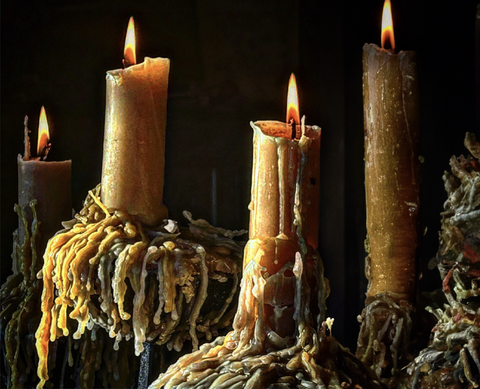In the softly flickering light of a beeswax candle, we can reconnect with centuries of human history. The humble beeswax candle, once a luxury reserved for nobility and churches, now offers modern homes a touch of authentic medieval ambiance and natural purity.
A Heritage of Light: Beeswax in the Middle Ages
Did you know that during medieval times, the finest candles were crafted from pure beeswax? While the common folk relied on tallow (animal fat) candles that produced smoke and unpleasant odours, the golden glow of beeswax was prized in cathedrals, monasteries, and royal courts across Europe.
The historical record shows that beeswax candles were deeply integrated into medieval religious and secular life. The Church became the primary consumer of beeswax candles, requiring them for countless ceremonies and rituals... I'm pretty sure pagans got their hands on them too!

Why Beeswax Reigned Supreme
The superiority of beeswax candles wasn't just symbolic – it was practical. Unlike their tallow counterparts, beeswax candles:
- Burned with remarkable clarity and brightness
- Produced virtually no smoke or soot
- Released a subtle, natural honey fragrance
- Lasted significantly longer than other lighting sources
These qualities made beeswax the premium choice for illumination, despite its higher cost. Historical documents reveal that medieval cathedrals would spend vast sums on beeswax candles for important feast days, sometimes using hundreds or even thousands in a single celebration. - I'm unsure if I could produce those numbers, but I'd give it a try!
The Art of Medieval Candle Making
Beeswax production was a sophisticated craft in the Middle Ages. Expert candlemakers developed techniques that have been passed down through generations:
First, honeycomb was carefully collected from beehives and melted to separate the wax from honey and impurities. The wax was then purified through a series of filtrations, resulting in a substance of remarkable clarity and golden hue. Skilled artisans would then shape the warmed wax, often using specialised moulds or dipping techniques that required years to master.
From Medieval Monasteries to Your Living Room
Today's handcrafted beeswax candles carry forward this rich tradition. When you light one of our premium beeswax candles, you're participating in a ritual that connects you directly to medieval craftspeople who understood the value of natural materials and meticulous workmanship.
Our beeswax candles are created using methods inspired by medieval techniques, resulting in products that would be recognisable to a 13th-century monk or noble. The same golden light that illuminated medieval manuscripts and castle halls can now transform your home with its warm, authentic glow.
Produced from local Cheshire bees!
Health Benefits: Medieval Wisdom for Modern Living
Long before modern science confirmed it, medieval people understood that beeswax candles offered benefits beyond their beautiful light. Today we know that beeswax naturally produces negative ions when burned, which can help purify air by reducing dust, allergens, and pollutants – a natural cleanser for your living space.
Experience the Difference of Historical Authenticity
Each of our beeswax candles represents the culmination of centuries of craftsmanship. Unlike mass-produced paraffin candles (a petroleum byproduct), our beeswax creations offer:
- A historically authentic experience
- All-natural ingredients that medieval artisans would recognise
- The same subtle honey aroma enjoyed by kings and clergy
- Clean-burning properties that won't discolour your walls or ceilings
- Longer burning times, just as medieval users valued
Discover all SÆR handmade candles
Click to discover how introducing our candles to your home can help keep other traditions alive.

